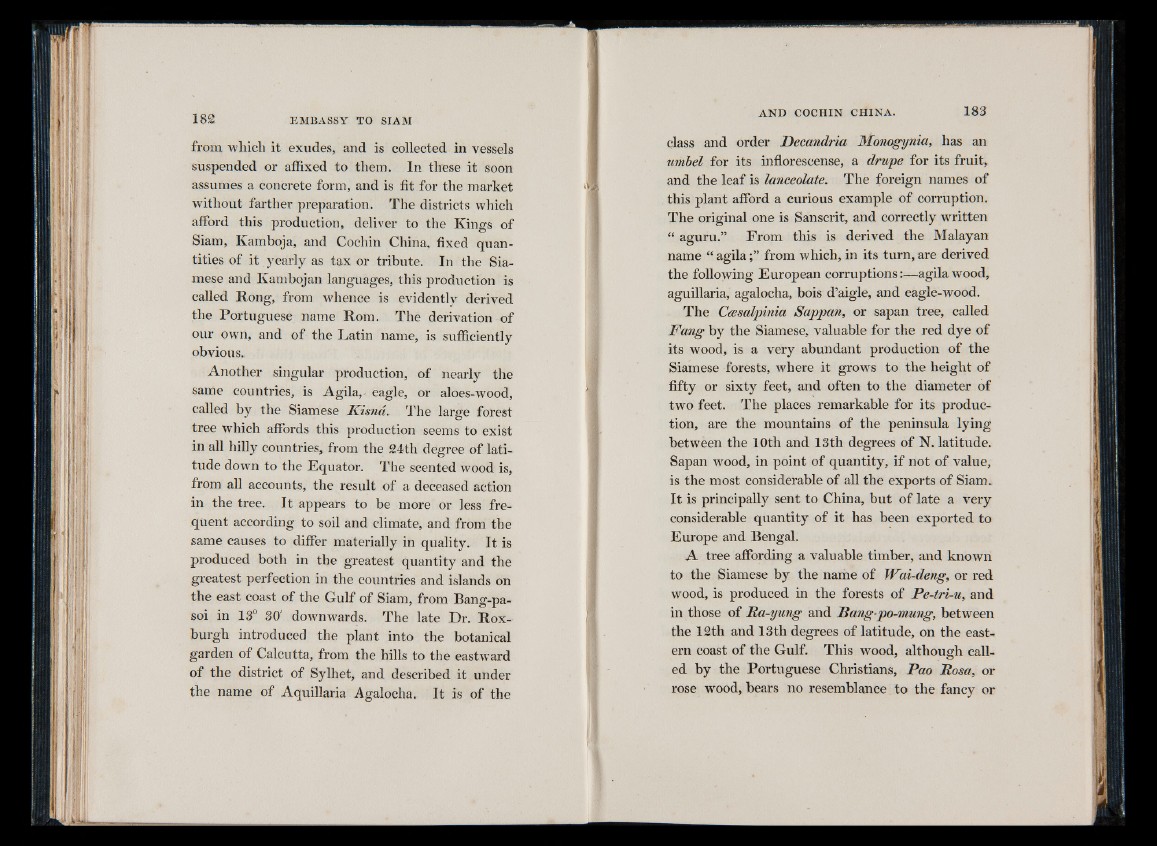
from which it exudes, and is collected in vessels
suspended or affixed to them. In these it soon
assumes a concrete form, and is fit for the market
without farther preparation. The districts which
afford this production, deliver to the Kings of
Siam, Kamboja, and Cochin China, fixed quantities
of it yearly as tax or tribute. In the Siamese
and Kambojan languages, this production is
called Hong, from whence is evidently derived
the Portuguese name Rom. The derivation of
our own, and o f the Latin name, is sufficiently
obvious.
Another singular production, of nearly the
same countries, is Agila,- eagle, or aloes-wood,
called by the Siamese Kisnâ. The large forest
tree which affords this production seems to exist
in all hilly countries, from the 24th degree of latitude
down to the Equator. The scented wood is,
from all accounts, the result of a deceased action
in the tree. It appears to be more or less frequent
according to soil and climate, and from the
same causes to differ materially in quality. It is
produced both in the greatest quantity and the
greatest perfection in the countries and islands on
the east coast of the Gulf of Siam, from Bang-pa-
soi in 13° 30 downwards. The late Dr. Roxburgh
introduced the plant into the botanical
garden of Calcutta, from the hills to the eastward
of the district of Sylhet, and described it under
the name of Aquillaria Agalocha. It is of the
class and order Decandria Monogynia, has an
umbel for its inflorescense, a drupe for its fruit,
and the leaf is lanceolate. The foreign names of
this plant afford a curious example of corruption.
The original one is Sanscrit, and correctly written
“ aguru.” From this is derived the Malayan
name “ a g il a f r o m which, in its turn, are derived
the following European corruptions:—agila wood,
aguillaria, agalocha, bois d’aigle, and eagle-wood.
The Ccesalpinia Sappan, or sapan tree, called
Fang by the Siamese, valuable for the red dye of
its wood, is a very abundant production of the
Siamese forests, where it grows to the height of
fifty or sixty feet, and often to the diameter of
two feet. The places remarkable for its production,
are the mountains of the peninsula lying
between the 10th and 13th degrees of N. latitude.
Sapan wood, in point of quantity, if not of value,
is the most considerable of all the exports of Siam.
It is principally sent to China, but of late a very
considerable quantity of it has been exported to
Europe and Bengal.
A tree affording a valuable timber, and known
to the Siamese by the name of Wai-deng, or red
wood, is produced in the forests of Pe-tri-u, and
in those of Ra-yung and Bang-po-mung, between
the 12th and 13th degrees of latitude, on the eastern
coast of the Gulf. This wood, although called
by the Portuguese Christians, Pao Rosa, or
rose wood, bears no resemblance to the fancy or